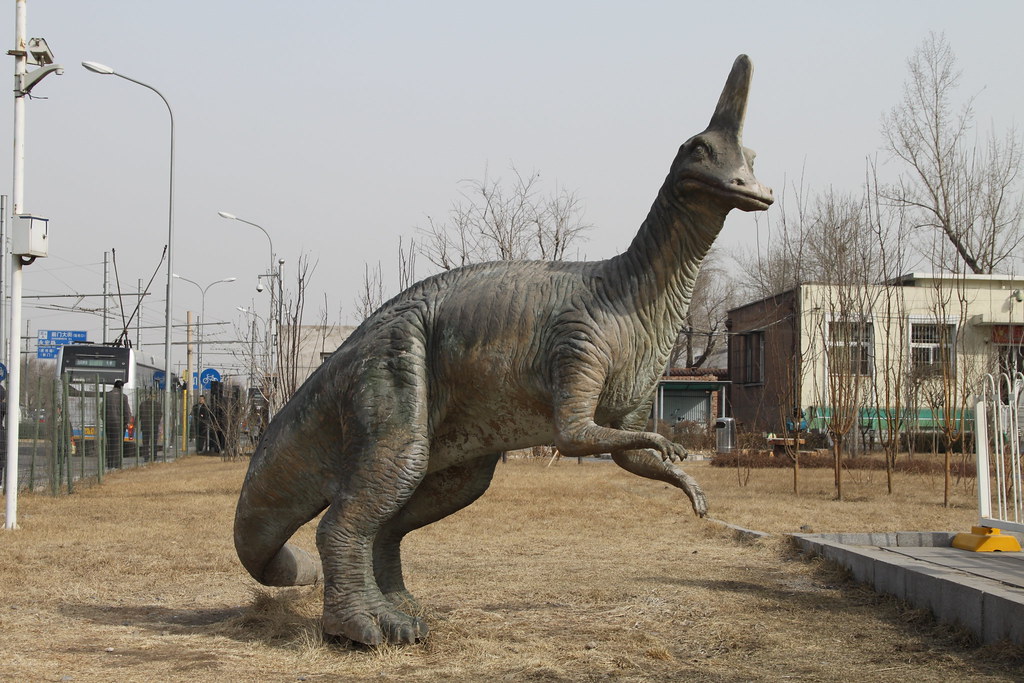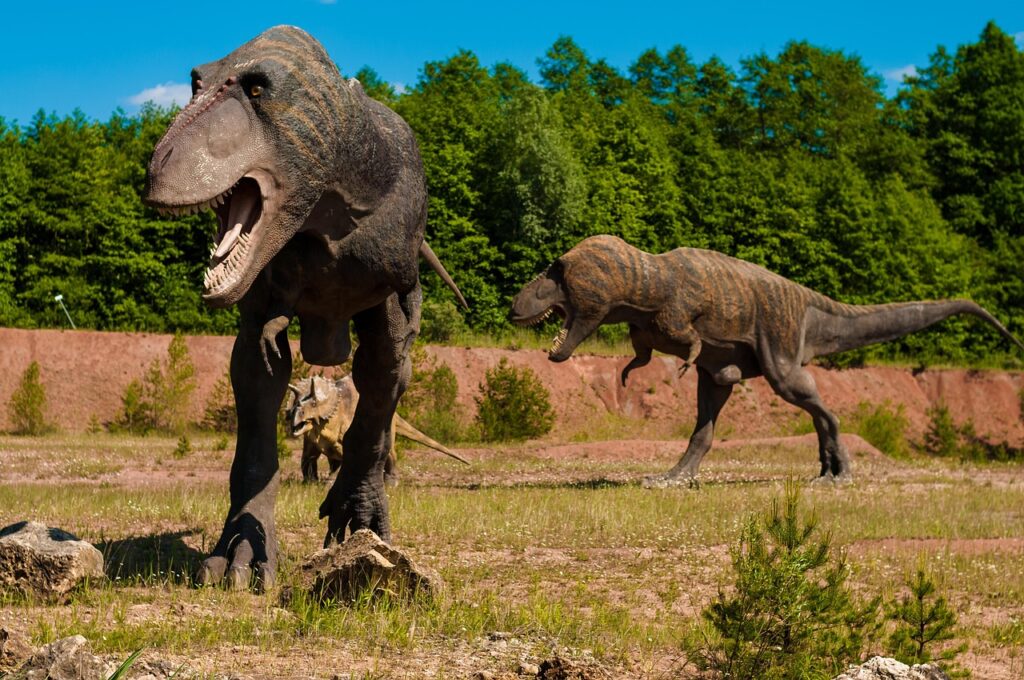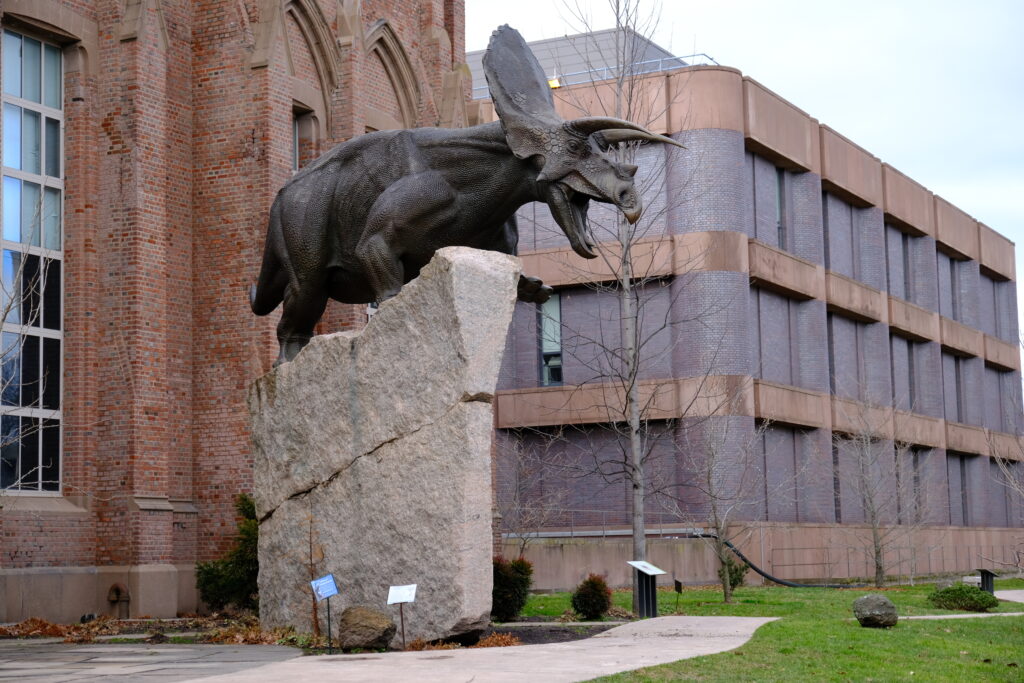Picture ancient forests filled not with bird songs but with the haunting calls of massive creatures. These weren’t your typical roars, but something far more sophisticated. Prehistoric giants used elaborate head crests as natural sound systems, creating a symphony that echoed across continents millions of years ago.
The discovery of how these dinosaurs communicated has revolutionized our understanding of prehistoric life. Scientists now know that these creatures possessed the brain power to engage in complex communication, using resonating chambers in their crests to produce low-frequency sounds that could travel vast distances. Let’s dive into the world of crested dinosaurs and explore how their unique anatomy transformed them into the musicians of the Mesozoic era.
Parasaurolophus: The Trombone Player of the Cretaceous

Parasaurolophus stands out with its large, bony crests arching over the back of their heads like a single blunted horn, and scientists made the discovery by examining the tubelike holes inside the crest. One paleontologist created a replica using plastic pipes he could blow into and out came a low-pitched sound around 48 Hz frequency. The hollow tubes within their crests functioned like prehistoric wind instruments.
Computer simulations based on CT scans of fossil skulls suggest these dinosaurs could have produced resonant, low-frequency sounds similar to those of brass instruments. Think of it as nature’s own trombone section, with each species producing its unique musical signature. The varied crest shapes among different hadrosaur species indicate these structures likely served as species recognition signals through their distinctive sounds.
Corythosaurus: The Helmet-Wearing Vocalist

The internal structures of the crest of Corythosaurus are quite complex, making possible a call that could be used as a warning or for attracting a mate. Any vocalization would travel through these elaborate chambers and probably get amplified. Named for its resemblance to ancient Greek helmets, this dinosaur was perfectly equipped for long-distance communication.
Scientists speculate that Corythosaurus could make loud, low pitched cries like a wind or brass instrument, such as a trombone. The nasal passages emit low-frequency sounds when Corythosaurus exhaled. The individual crests would produce different sounds, so it is likely that each species of lambeosaurine would have had a unique sound. Each individual likely had their own vocal fingerprint, making prehistoric gatherings sound like orchestrated concerts.
Lambeosaurus: The Hatchet-Headed Trumpeter

The crest projects well above the eye and slightly over the snout, and adults of some species possess a backwards spur. The function of the crest could have been used as a resonating device for vocalisation, with a secondary function of sexual or species identification. The distinctive hatchet shape made each species unmistakable both visually and acoustically.
In L. lambei, the crest resembled a hatchet with a forward-projecting blade and a solid bony handle extending over the skull’s back. This crest, evolving into its full form as the dinosaur approached adulthood, consisted of a thin upper coxcomb and a lower portion housing the nasal passages. Growing up meant developing a more sophisticated sound system, much like human voices changing during adolescence.
Hypacrosaurus: The High-Crested Communicator

Like other lambeosaurine dinosaurs, Hypacrosaurus had a distinct crest on its head. The hollow crest was similar to that of the closely related Corythosaurus but had a wider profile and wasn’t as high. This adaptation suggests different acoustic properties, producing sounds distinct from its relatives.
It is related to other hadrosaurs such as Hypacrosaurus, Lambeosaurus, and Olorotitan. Among these are two species of Hypacrosaurus in the Horseshoe Canyon and Oldman formations of Canada and the Upper Two Medicine Formation of Montana. All of these dinosaurs – except one species of Hypacrosaurus – were found to be contemporaries of Corythosaurus. Living alongside multiple crested species created complex acoustic environments where clear species identification was crucial.
Charonosaurus: The Asian Echo Chamber

Another closely related dinosaur, Charanosaurus jiayinensis, was discovered in the Yuliangze Formation of Heilongjiang, China, in 2000. Charanosaurus jiayinensis was a contemporary of Hypacrosaurus altispinus. This Asian relative demonstrates how crested dinosaur communication systems spread across continents during the Late Cretaceous.
Nasal passageways of Corythosaurus, as well as Hypacrosaurus and Lambeosaurus, are S-shaped, with Parasaurolophus only possessing U-shaped tubes. These anatomical variations likely produced distinctly different sound qualities, allowing for sophisticated acoustic diversity across species and geographic regions.
Olorotitan: The Fan-Crested Swan

The Olorotitan can be considered Europe’s version of the Lambeosaurus. This 26-foot-long hadrosaur was about the same size as its North American cousin but lived halfway across the world in Eastern Russia. The name Olorotitan, which means titanic swan, is a reference to this unusually long neck. Its unique anatomy suggests a specialized acoustic niche.
The crest curved high over the dinosaur’s skull and was supported by backward-pointing bone with a distinct fan shape. Like other hadrosaurid dinosaurs, the crest of the Olorotitan was hollow and covered with keratin material. The crest was probably colored and may have been used for identification or courtship purposes. Visual and acoustic signals worked together to create complex communication systems.
Nipponosaurus: The Japanese Sound Maker

Benson et al. found that Corythosaurus was closely related to Velafrons, Nipponosaurus, and Hypacrosaurus, with them forming a group of fan-crested lambeosaurines. This Asian species shared the hollow crest anatomy that enabled acoustic communication across the lambeosaurine family tree.
The presence of crested hadrosaurs throughout Asia demonstrates how successful this communication strategy was. Different continents developed their own versions of these living sound systems, each adapted to local environments and social needs. The fan-shaped crest design appears to have been particularly effective for sound amplification.
Velafrons: The Mexican Horn Section

Velafrons represents the southern extent of crested hadrosaur distribution in North America. Found that Corythosaurus was closely related to Velafrons, Nipponosaurus, and Hypacrosaurus, with them forming a group of fan-crested lambeosaurines. This suggests a common acoustic heritage among fan-crested species across vast geographic distances.
The Mexican discovery of Velafrons expanded our understanding of how far these communication systems spread. Living in different climates and ecosystems, these dinosaurs faced unique acoustic challenges. Dense forests require different sound frequencies than open plains, and their crest designs likely reflected these environmental demands.
Procheneosaurus: The Juvenile Voice

Corythosaurus casuarius is one of a few lambeosaurines, along with Lambeosaurus lambei, Hypacrosaurus stebingeri, and H. altispinus, to have had surviving fossilized juveniles assigned to it. Juveniles are harder to assign to species because, at a young age, they lack the distinctive larger crests of adults. What we once thought was a separate species turned out to be young dinosaurs with undeveloped communication equipment.
The larger crests of mature animals would help make different sounds compared to the voices of juveniles. In a way, this is similar to our own species in which the male voice breaks prior to the onset of adulthood. Just like human teenagers, young hadrosaurs had to wait for their voices to mature before they could participate fully in adult conversations.
Tetragonosaurus: The Four-Sided Mystery

This work resulted in the naming of two new species of Lambeosaurus, L. clavinitialis and L. magnicristatum, and one new species of Tetragonosaurus, T. cranibrevis. Originally thought to be a separate genus, Tetragonosaurus specimens are now understood to represent different growth stages or variations within established species.
The smallest specimens were identified as Tetragonosaurus, now seen as a synonym of Procheneosaurus, and the largest skeletons were called either Corythosaurus or Lambeosaurus. This taxonomic confusion actually reveals something fascinating about dinosaur development. Their communication systems evolved throughout their lives, with young dinosaurs gradually developing the full acoustic capabilities of adults.
The Science Behind the Sound

The internal passages within these crests could have acted as resonating chambers, allowing dinosaurs to produce low-frequency sounds, perhaps similar to a trombone or bassoon. These sounds could have traveled long distances, facilitating communication for purposes such as warning others of predators, coordinating herd movements, or attracting mates. Modern technology has unlocked the secrets of these prehistoric sound systems.
Modern imaging technologies, such as CT scans, have revolutionized the study of hollow crests. CT scans of Parasaurolophus crests have revealed intricate air passages and chambers, providing strong evidence for their role in sound production. Digital models from these scans enable further analysis of airflow and resonance. We can now literally recreate the voices of creatures that died out 66 million years ago.
The world of crested dinosaurs reveals a prehistoric landscape filled with complex communication networks. These ancient creatures developed sophisticated sound systems that allowed them to coordinate movements, attract mates, and warn of dangers across vast distances. The ability to produce low-frequency sounds likely played a crucial role in their communication and social dynamics.
What’s truly remarkable is how similar their communication needs were to our own. They needed to identify friends from strangers, coordinate group activities, and express emotions. Their hollow crests gave them the tools to create a rich acoustic world that we’re only now beginning to understand. Did you expect that dinosaurs were such sophisticated communicators?



